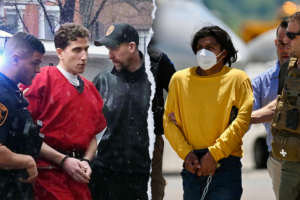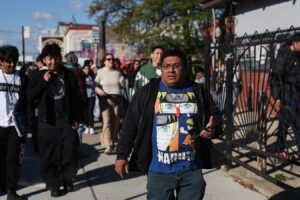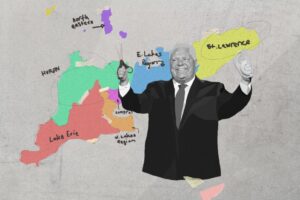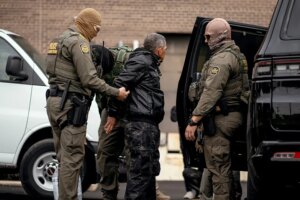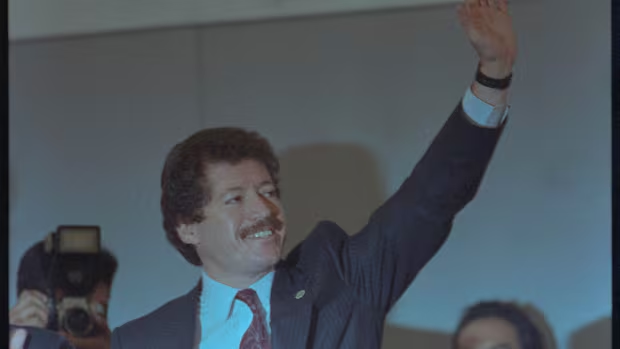
At Mexico City’s El Calife de Leon, on the wall with two red Michelin star plaques above a sign listing the tacos on the menu, hangs a framed, blown-up print of a newspaper page with a sketched portrait of assassinated presidential candidate Luis Donaldo Colosio.
The March 23, 1994, death of Colosio, a reformer on the cusp of winning the presidency who promised a more just and democratic country, holds a space in the Mexican consciousness like the 1963 killing of President John F. Kennedy does in the United States.
Angel Rodríguez Ávila, El Calife de León’s chef, said he often served Colosio, who frequented the taco stand, sometimes alone, sometimes with a contingent, before two bullets hit the candidate in the head and stomach during a campaign stop in Lomas Taurina, Tijuana, and forever altered Mexico’s political firmament.
“There are many things we don’t know and will never know [about Colosio’s assassination],” said Rodríguez Ávila, while grilling cuts of salted steak and pork this past Tuesday at the taco stand that is the first to receive a Michelin star in the country.
“Maybe it’s better if it stays like that.”
Days earlier, on Nov. 8, Mexican federal authorities arrested a 64-year-old man in Tijuana in connection with Colosio’s killing.
The arrest of Jorge Antonio Sánchez Ortega, a former intelligence officer from a now-defunct federal agency, added another layer to one of most complex, loaded and pivotal events in Mexico’s modern history.
Through the arrest, the administration of Mexican President Claudia Sheinbaum is challenging what has been the long-held official story around Colosio’s assassination.
A successful prosecution by the Attorney General’s office of Sánchez Ortega would go a long way in proving a theory originally rasied and then discarded by the first special prosecutor assigned to the case that Colosio’s killing was the result of a plot concocted by actors within or connected to the machinery of the state — that the hit on Colosio was an inside job.
Luis Donaldo Colosio, then president of Mexico’s Institutional Revolutionary Party, acknowledges applause at a party on Sept. 1, 1990. (Santiago Lyon/Reuters)
The Attorney General’s Office did not respond to a request for comment.
The office of Sen. Luis Donaldo Colosio Riojas, Luis Donaldo Colosio’s son, said he would not comment on the arrest of Sánchez Ortega. Colosio Riojas, part of the Citizen’s Movement party, has yet to speak publicly on the arrest.
‘Mother-of-all historical truths’
For the better part of the last 30 years, the official version of events, backed by three out of four special investigations into the case, stated that Colosio was killed by two bullets fired from a Taurus .38 Special revolver held by Mario Aburto, who was 23 at the time and acted alone.
A video camera filming Colosio’s movement through a swarming crowd captured the image of a revolver, which was pointed at Colosio’s head and appeared to fire at point-blank range. It’s not clear from the video who was holding the gun.
Aburto was grabbed by members of the crowd who claimed he was the shooter. Since then, Aburto has remained, officially, the lone shooter responsible for the assassination.
He was convicted and given a 45-year sentence for killing Colosio and remains incarcerated in a federal prison west of Mexico City. A court in 2023, after a finding that he had been tried in the wrong jurisdiction, reduced his sentence to 30 years, which would have led to his release last year, but Mexico’s highest court temporarily stayed the ruling.
Aburto claims he was tortured into confessing. His lawyer, Jesús González Schmal, told CBC News authorities detained his mother and sister, stripped them naked, photographed them and showed Aburto their photos.
“He felt defeated and said, ‘I’ll do whatever you tell me to do,'” said González Schmal.
Aburto’s family fled to the U.S., where they remain.
Mario Aburto, right, is grabbed by security personnel after Luis Donaldo Colosio was shot in Tijuana, Mexico, on March 23, 1994. (Reuters)
This version, first announced by the then-attorney general within hours of Colosio’s death, has never been fully accepted in popular opinion since its inception.
“This is the mother of all historical truths that have been constructed in our country since 1994,” said Laura Sánchez Ley, a prominent Mexican journalist who has written a book about Aburto and successfully fought for the release of tens of thousands of pages from the investigative record.
The term “historical truth” in Mexico is generally used to describe a theory crafted by government players, law enforcement and politicians, often amplified by the media, that becomes the dominant version of a major event.
“The Colosio case has been very much manhandled throughout all these years … it’s been corrupted by Mexican authorities who’ve tried to cover up all the irregularities in the investigation of this case,” said Sánchez Ley.
There’s another theory that surfaced during a 1997 special investigation into Colosio’s assassination that has also persisted alongside the official story — that a second person may have also fired at Colosio.
And in this second-shooter theory, Sánchez Ortega is the main person of interest.
A file on Jorge Antonio Sánchez Ortega is part of the record from the investigation into the 1994 assassination of Louis Donaldo Colosio. (CBC)
Sánchez Ortega was a low-level intelligence officer with the National Centre for Investigations and Security (CISEN) when he was sent to monitor Colosio’s campaign in Lomas Taurina.
At the time, Colosio appeared to be a lock for the presidency. Not only was he a talented, charismatic and popular politician with a common touch, but he was also ordained to be Mexico’s next leader by then president Carlos Salinas.
Colosio and Salinas belonged to the same party, the Institutional Revolutionary Party (PRI), which had ruled Mexico as a one-party state since 1929. During the PRI’s seven-decade hold over federal power, the president always selected his replacement.
Sánchez Ortega was detained in the immediate aftermath of Colosio’s death. He was found with Colosio’s blood on his clothes. He claimed the stains came from carrying the slain politician’s body in the aftermath of the shooting, said Sánchez Ley.
His hands were also tested with sodium rhodizonate, which found suspected residue consistent with the discharge of a firearm. Sánchez Ortega claimed he didn’t have a gun because he was forbidden from carrying a weapon while on duty, said Sanchez Ley.
Sánchez Ortega was questioned in each of the four previous investigations and reinvestigations launched between 1994 and 2000 into Colosio’s assassination, she said.
He was discarded as a suspect in the last, exhaustive reinvestigation of the case, according to a special prosecutor’s report completed in 2000.
“It’s certain that” Sánchez Ortega, who looked similar to Aburto, “was not found near” Colosio at the moment of the killing, said the report, which also dismissed the second-shooter theory.
“I’ve always said that in these types of cases, when politics and the law confront each other, politics regularly triumphs to the detriment of justice,” said Iñaki Blanco, a former attorney general of the state of Guerrero who was part of the team that produced the 2000 report.
Weaving its own theory
Yet, shortly after taking power, the Sheinbaum administration began to weave its own second-shooter theory with a thread that ran through the National Action Party’s 2006-2012 presidency of Felipe Calderon to Salinas’s PRI administration, which ended in 1994.
On Oct. 18, 2024, during Sheinbaum’s morning media conference, Interior Secretary Rosa Icela Rodríguez called Sánchez Ortega the “so-called second shooter” in the Colosio case.
Icela Rodriguez alleged that he was “rescued” from his detention in the wake of the Colosio assassination by a CISEN subdirector named Genaro Garcia Luna, who helped cover up his role in the event.
“It is duly proven that CISEN sent the accused, García Luna, to the scene of the events, and then covered for [Sánchez Ortega] and urgently and surreptitiously removed him from Tijuana,” Icela Rodriguez said during the media conference.
Garcia Luna eventually became Calderon’s secretary for public safety. He was later convicted and sentenced on Oct. 16, 2024, by a U.S. federal court to 38 years in prison for taking bribes from cartels.
Luna is appealing his conviction and is at the ADX Florence supermax prison in Florence, Col.
His lawyer, Cesar de Castro, said he’s had difficulty communicating with Luna.
“Our priority is working on his appeal under very difficult conditions and fighting for his freedom,” de Castro said in an emailed statement.
The Sheinbaum administration picked up the case against Sánchez Ortega from the previous administration of president Andrés Manuel López Obrador.
Mexican President Claudia Sheinbaum, left, and outgoing president Andres Manuel Lopez Obrador wave on Oct. 1, 2024, as part of the presidential inauguration in Mexico City. (Manuel Velasquez/Getty Images)
Sheinbaum and López Obrador belong to the same party, the National Regeneration Movement (Morena), which has become the dominant political force in the country.
The newspaper Reforma recently reported that the Attorney General’s Office twice failed, in late 2023 and early 2024, during the waning months of López Obrador’s administration, to obtain an arrest warrant for Sánchez Ortega.
But following judicial reforms that came into force on Sept. 1, 2025, to elect all the country’s judges, the Sheinbaum government got the needed signature for the warrant.
On Sept. 25, federal authorities successfully filed a request with a Mexican court to obtain a search warrant for Sánchez Ortega on suspicion he committed an aggravated homicide in relation to Colosio’s death. The aggravating factors in the homicide included premeditation and lying in wait for an ambush, the filed document said, citing various statutes.
The filing included a list of 43 pieces of evidence, mostly DVDs, some with videos from television networks, which were filed with the court in a sealed envelope, according to a copy of the document shared with CBC News by the Milenio newspaper.
A judge on Saturday ordered Sánchez Ortega to remain detained in a maximum security prison called El Altiplano, about 70 kilometres west of Mexico City.
‘Changed Mexico’
Colosio rose to the edge of presidential power during a hinge point in Mexican history. The PRI was losing its grip on power and facing a growing social movement demanding greater democracy.
Salinas, who won an election tainted by allegations of vote fraud levelled by his main opponent, was pushing Mexico into the neoliberal currents of the times, signing the North America Free Trade Agreement while selling off state assets at home, creating anger on both the left and in the old-guard right.
Colosio, the PRI candidate, offered a path to slow the country’s right-ward, neoliberal tilt, while also promising fundamental social justice and democratic reforms.
“I see a Mexico with a hunger and thirst for justice … of women and men afflicted by the abuse of the authorities and the arrogance of government offices,” Colosio said during his famed March 6, 1994, speech in Mexico City’s Monument to the Revolution plaza.
WATCH | Luis Donaldo Colosio’s famous speech:
The death of Colosio changed the course of Mexico’s political history, setting off a chain of events that helped speed the demise of the once all-powerful PRI, which lost the presidency in 2000. The PRI is now a shell of its former self, barely holding 10 per cent of the seats in the lower house of deputies.
“It was an event of great transcendence that changed Mexico,” said Federico Arreola Castillo, a journalist and friend of Colosio’s.
Arreola was there that day in Lomas Taurina, standing with a doctor next to a vehicle that was part of the campaign convoy. They were waiting to leave for a meal with Colosio when the gunshots rang out.
“We ran over because everyone was calling for a doctor,” he said. “It was horrible to see Luis Donaldo … to see Luis on the ground. It was a really ugly thing.”
Arreola said the criminal investigation into the assassination was tainted from the beginning. He said he’s always had doubts about the official narrative, including whether Aburto was truly the killer.
Arreola said he would support a full reopening of the case and the reinterrogation of all the political players, including former presidents Salinas, who preceded Colosio, and Ernesto Zedillo, who took over the PRI candidacy in 1994 and became president.
“[The event] should be reconstructed, with rigour, within the political context [of the time] so we can try to come to some conclusions,” said Arreola. “Maybe, legally, we can’t punish anyone, but Mexico deserves a better explanation than what we have.”
Agustín Basave Benítez, left, speaks with his friend Luis Donaldo Colosio. Basave Benítez was one of Colosio’s presidential campaign advisers. (Submitted by Augustin Basave Benitez)
Agustín Basave Benítez, a friend of Colosio and one of his presidential campaign advisers, said he doesn’t believe there is any concrete evidence linking Sánchez Ortega to Colosio’s killing,
The push to reopen the case on grounds that there was a second shooter, which was started by López Obrador and continued by Sheinbaum, is driven more by politics, perhaps as a distraction or to attack a political target, than a search for truth, he said.
“When people say to me Colosio’s case should be reopened, I say, if there’s new elements, if the intention isn’t political, but one for justice, to get to the truth, then let’s go,” said Basave Benítez, a professor, author and former federal lawmaker.
“But in this case, it’s not.”
Basave Benítez still remembers that fateful Wednesday when Mexico’s political world spun off its axis. He was a PRI federal lawmaker and sitting in the Chamber of Deputies when he was told by a radio reporter that Colosio had been shot.
“I went running to my office and picked up the phone … I looked for various people who could confirm it…. And I asked, where was he shot? In the head [came the response]. That’s when I started to lose hope,” said Basave Benítez.
He gave his cellphone to an assistant with a request to screen all calls. Then his son, who was around nine, phoned and the assistant let this one through.
“And he was crying and he said, ‘Papa, are you OK, are you OK, Papa?” said Basave Benítez.
“And I told him that I was OK…. And he says, ‘Is he going to die? Is Donaldo going to die? And I said, ‘I hope not….’ And the final thing he said, ‘Promise me one thing, promise me you won’t ever be a presidential candidate.’”
‘He treated us as equals’
Colosio’s assassination became a historical touchstone for everyone who lived through the event in the country and left a deep imprint that remains painful to this day, said Basave Benítez.
“Many people still say to me, I was in this place or I heard on the radio or I saw it on television.”
The portrait of Colosio that hangs at El Calife de León illustrates an article that describes a chance, late evening encounter with the politician in “the most egalitarian dining room in Mexico,” where tacos are served on plastic plates as patrons dine, standing, pressed shoulder to shoulder, dripping sauce over the countertops.
“He treated us as equals and we, likewise, treated him like everyone else, even though we knew that he was a candidate for president,” said Rodríguez Ávila.
A framed, blown-up print of a newspaper page showing a sketched portrait of assassinated presidential candidate Luis Donaldo Colosio hangs at El Califa de Leon in Mexico City. (Hector Vivas/Getty Images)
Source

